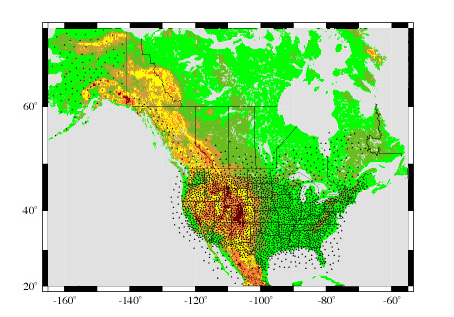geotimesheader
Highlights
Structure
and Tectonics
Christian
Teyssier
After
2,000 stations are installed in the United States, including Alaska, as
well as
Canada, Mexico and the continental margin, USArray will cover the above
area.
GSA Today. |
The year 1999 was fertile for structural geology
and tectonics. A good summary of the major questions in structural geology
appeared in the 20th anniversary volume of the Journal of Structural
Geology. A number of authors reflected on the way one should approach
structural studies, from an observational standpoint to a full use of solid
and fluid mechanics. The special volume also showed that the processes
and theory of faulting are very strong areas of research. The series of
earthquakes that punctuated the year, especially those in Turkey and Mexico,
reemphasized our poor knowledge of faulting and the need for field studies
to complement seismological monitoring. |
A large-scale geoscience initiative is being developed
around EarthScope, a project supported by the National Science Foundation
that will significantly impact research in North America. Part of EarthScope,
the USArray program is an unprecedented effort to seismically image Earth’s
deep interior under the North American continent. USArray will also scan
the continent with Big Foot, a network of portable seismometers, over 10
years. Results will display coarse lithospheric structures as well as mantle
heterogeneities down to the core-mantle boundary.
Of interest to tectonicists, USArray will also
deploy about 2,000 additional seismometers over specific target regions
to investigate fundamental geologic problems at the crust/lithosphere scale.
These regions have yet to be determined, but the potential for new insights
and discoveries is great. Target regions will be imaged at an unparalleled
resolution and in three dimensions, allowing a better understanding of
their geologic histories.
Such probing of North America will address key
questions on the assembly of the continent and the relationship between
lithospheric and crustal dynamics. The success of this initiative depends
on the synergy that will develop among the various disciplines. It is clear
that tectonicists have a major role to play.
A good example of a successful marriage between
seismology and tectonics is illustrated in one of the most exciting papers
published in the past year. Peter Molnar and co-authors (Science,
v. 286, p. 516-519) compiled data on the deformation of a key plate margin,
the Pacific-Australian plate boundary in New Zealand, where plates have
been sliding past each other over the last 45 million years. Using shear-wave
splitting, Molnar’s team showed that New Zealand is underlain by a mantle
shear zone a few hundred kilometers wide — a sharp contrast to oceanic
transform plate boundaries that are typically narrow.
Shear-wave splitting has established itself as
a new technique for determining the structural geology of the mantle. Splitting
of shear waves is interpreted to originate from the preferred orientation
of olivine, the dominant mineral in the upper mantle, developed during
ductile deformation by dislocation creep (Savage, 1999, Reviews of Geophysics,
v. 37, p. 65-106).
The work by Molnar and his colleagues has profound
implications for understanding the relationship between mantle and crustal
deformation, and for understanding the mechanical coupling that exists
among the lithosphere’s rheologic layers. This work adds substantially
to the theory of plate tectonics by showing that continental plates are
not rigid and that the mantle lithosphere deforms over broad regions at
plate margins.
Some fundamental questions remain: How far do
large faults in the upper crust continue at depth? Is deformation of the
continental crust controlled by the imposed displacements in the mantle?
What happens to the deforming (thickening) lithosphere over time?
Ultimately, lithospheric coupling must play a
significant role in stress loading the upper crust and generating earthquakes
along the major faults that dissect continents. It is time for “brittle”
and “ductile” geologists to join forces and understand the relationship
between continuous deformation and seismic displacements at the crust and
lithosphere.
Teyssier teaches in the Department
of Geology and Geophysics at the University of Minnesota. Visit www.geo.umn.edu/people/profs/TEYSSIER.html
For more on USArray, visit
www.iris.iris.edu/background.II.html

